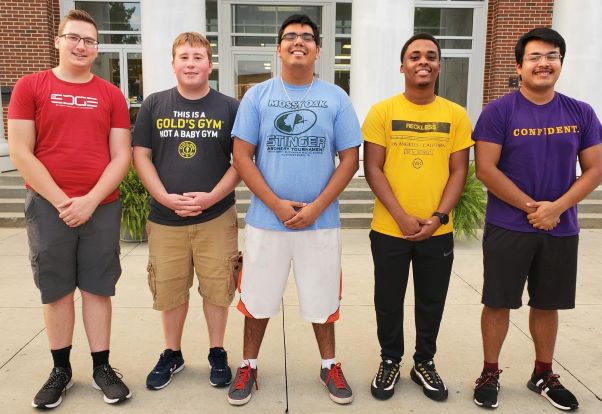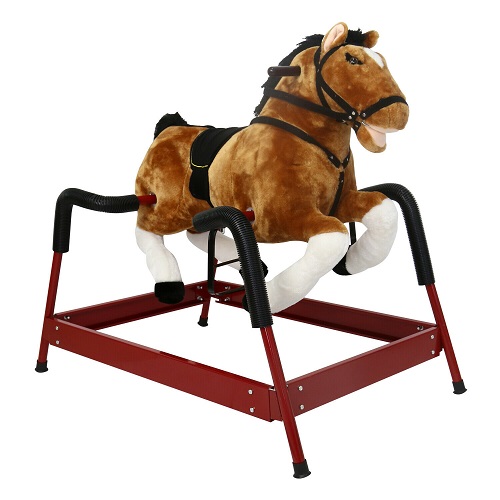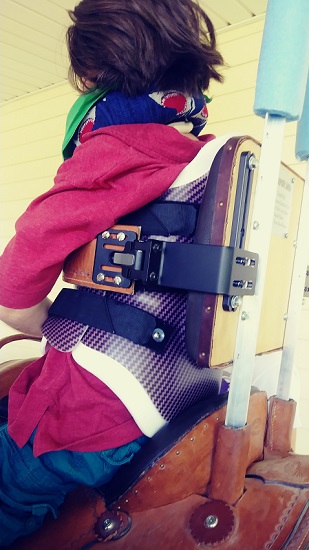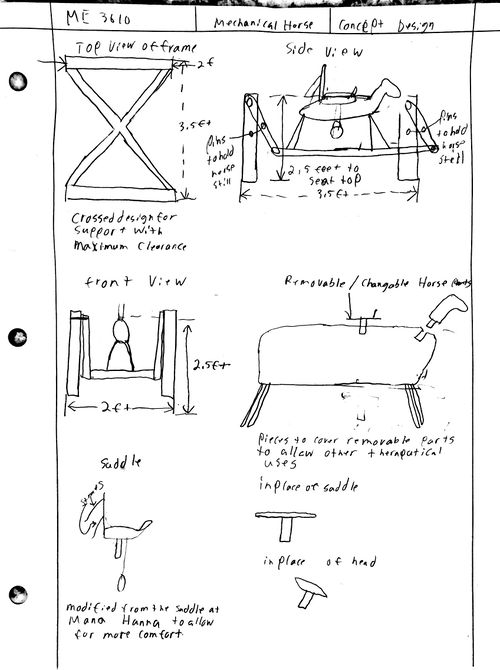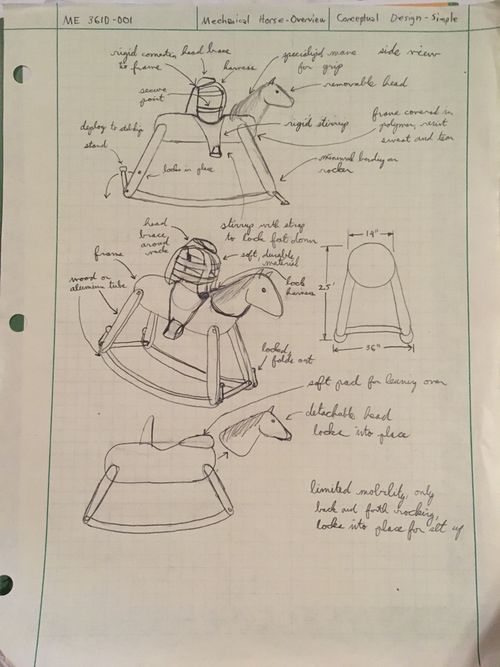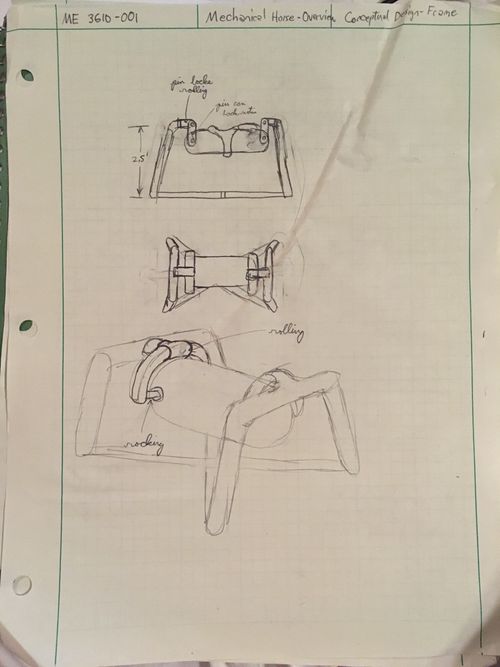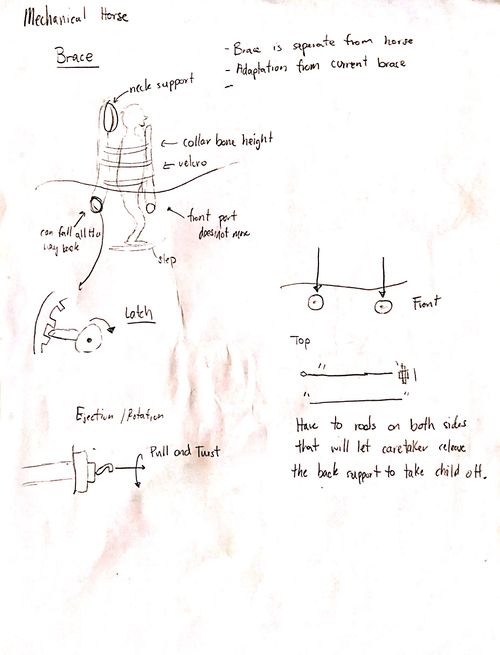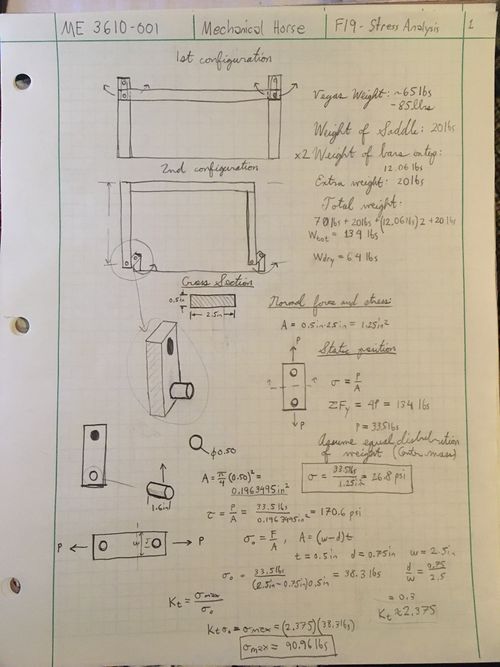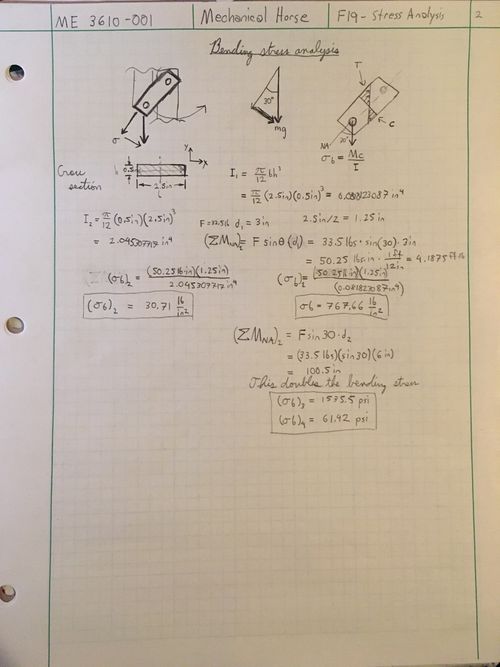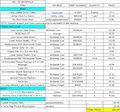Mechanical horse
Contents |
Abstract
Vegas has no leg and upper torso mobility. He needs a mechanical horse that mimics a horse's movement for therapy. Currently, other options for therapy are not well designed for limited mobility, take extended amounts of time to mount, and are uncomfortable for Vegas. He needs a mechanical horse that can be mounted quickly and safely while also being comfortable.
Team members
- Team Picture (Left to right)
- Collin McCuiston, Zachary Layne, Kelvin Encalada, Nathaniel Coleman, David Montero Olivares
Photo by
- Rachel M.
Problem Statement/overview of the need
A family with a child who suffers with mobility, balance, and posture issues has traditionally used horse riding therapy to help treat their child’s cerebral parlays and epilepsy. The current therapy program that the family is a part of is very inconvenient due to its location being very far to travel with a child who has Vegas’s condition, as well as the fact that many aspects of the treatment cause discomfort to the child. Therefore, the family needs a therapeutic toy that not only replicates the benefits of the horse therapy at home, but also supports the child’s condition without any discomfort or safety hazards.
Design Specifications
Design specifications include:
- Must replicate the textures and build of an actual horse
- Must have a specialized saddle that supports the child lack of stability
- Must replicate therapeutic lateral motion
- Must have both sitting up and laying down modes of therapy
- Must be secured in case of seizure
- Must be approximately waist height of mother (2 feet 5 inches) to accommodate set up
- Must be able to be used for approximately 2-3 year after implementation
Background research
1. What exists already, similar products 2. availability 3. identify gaps in existing products or technology to be addressed
After much research, our team found several products that simulate a riding horse ranging in the price of $50 to $180 for the age of our client, however, these products are bulky and take up too much space without a way to adjust or secure. This is a major problem for the family due to limited space in their home environment for equipment. One proposed idea would be to use the existing harness and further modify it to accommodate the necessary tasks. Another alternative would be constructing a harness and frame with many modified parts to better suit the child’s needs during hippotherapy. Such as the ability to lock and unlock the harness mobility and frame from a rocking motion.
The Mana Hannah Riding Center utilizes a similar harness type to the proposed harness our team will construct. After feedback from both Vegas’ mother and therapist, our team was able to conclude the following needs in regard to creating our riding horse: 1. Our client loses riding time due to the amount of time it takes to secure him on the saddle. 2. The harness not only restricts his ability to move in any direction, but is also stiff around his torso and fails to provide adequate support for his neck. The harness stiffness also causes him to be pushed forward by the cantle of the saddle causing discomfort around his hip/lower back area.
Conceptual Design
Summarize your conceptual design process. Develop at least three concepts.
Design Concept 1
- Description
This design is based off the design of a rocking chair combined with that of a hobby horse. This design allows the parents to precisely control the range of motion while their child still receives the therapeutic experience that horseback riding would give him. The frame is designed for maximum clearance from the horse, so there is no chance of pinching like might happen with a traditional spring designed hobby horse. It has pins to immobilize the rocker, that can be inserted into the frame much like weightlifting equipment to keep the horse stabile and allow for ease of access when getting the child in and out of the saddle. The therapist and mother also asked if we could make the horses head removable to allow for other therapeutic uses. To accomplish this request, the head is mounted with rectangular tubing to allow ease of access when removing and installing the head. The square tubing will also ensure that the head will remain straight and not spin just like it should be. When it is removed, you will be able to place the specially designed pad that fits flush with top of the horse into same rectangular tubing. The saddle that had been used in the past was not very comfortable for our client, because of the braces he had to wear. The saddle has been re-designed with modifications like removing the traditional back support to allow for maximum comfort, safety, and functionality, like the saddle previously used at Mana Hanna riding stables. The stirrups can also easily be adjustable with buckles just like the real thing. This will allow the saddle to be adjusted to our client as he grows.
- schematics/pictures/drawings
- estimates on performance
This design will allow a varied range of motion, and easy of access for the family.
Design Concept 2
- Description
A simple rocking horse design with limited motion for ease of use. Two fold out legs can lock down the frame and allow it to be stable during mounting and un-mounting. This design does not have side to side rocking however. The frame would be rugged with wood or aluminum tubing designed to support up to one-hundred pounds. The brace and saddle would be mounted to the frame with a soft polymer material for easy cleaning and comfort. The horse head with the mane for grip therapy would be removable with a simple sliding mechanism that locks into place. The stirrups are rigid and locked in place with straps for securing the feet. A sliding and locking mechanism could allow the stirrups to be adjustable over the necessary two years of use during development.
- Drawing
Design Concept 3
- Description
This frame design would utilize aluminum tubing and a rotating pivot to create all necessary ranges of motion. A single connection point to the frame allows for both forward and backward motion as well as rolling motion. Each of these motions can be independently locked down with a single pin. The frame's legs are secured by crossing underneath to each opposing leg, allowing for ease of access on both sides for mounting. Mobility would be limited to only a few degrees of motion to ensure safe operation in each axis. Just as the other designs, the brace would fit onto the center with a removable horse head and pad for lying forward. The stirrups would be rigid to prevent pinching and slipping.
- Drawing
- Performance Estimate
There's a chance that the hanging pendulum design could be unstable if there isn't enough length on the arm suspending the body of the mechanical horse. Too little length could cause the rolling motion to go too far.
Brace Concept
- Description
The following drawing is a design for a adaptation from the current brace. The front piece would be completely stationary but the back piece will have the ability to rotate back and forth, and locked into place using a sort of latch gear as shown. There will be two rods that go through the horse to release the latches and rotate the brace from either side. Further development will be documented.
- Drawing
Evaluate concepts/select candidate
Use a decision matrix or similar tool to compare designs against project specifications Discuss winning candidate
| DESIGN # | EASE OF USE | SUPPORT | STABILITY | MOBILITY | COST | TOTAL |
|---|---|---|---|---|---|---|
| 1 | 1 | 3 | 1 | 2 | 3 | 10 |
| 2 | 2 | 1 | 1 | 3 | 1 | 8 |
| 3 | 2 | 1 | 5 | 1 | 3 | 12 |
Design 2 is our winning concept
Detailed Design
This section will describe a detailed design process
Detailed description of selected design
For the final design we chose concept design 1 after hearing feedback from Vegas' therapist. We chose to modify the design to incorporate greater ease of assembly by reducing the cross design into a central core with struts. In addition, the location of rotation was moved closer to the base of the device. This way the design can more closely resemble a horse in motion, as well as allowing ease of locomotion for the body by simply pushing on one of the leg components. The whole mechanism will stand rough two and a half feet tall, and be about five feet long. The whole device will be approximately three-hundred pounds, with locking casters for easy locomotion.
The frame legs and base will be made of aluminum, with steel being used for the rotating joint which will be connected to the four legs and the base. This will allow the base to be sturdy enough for the extra weight of the wooden frame and brace needed for the size of the horse body, while also being lighter than wood or steel. Aluminum tubing will be used for the legs. A pin will be used to lock down the legs for safely mounting and un-mounting the horse. A steel sheet will be used to cut out the rotating joint needed, with two holes for placement. A steel shaft will be used with bearings for the rotation. This rod will have a section cut off and welded inside of one of the holes of the rotating joint, which will then be placed inside of a hole for the leg tubing. This will lead up to the body where bolts will be used to secure the body's frame to the legs.
The brace will consist of padding and a ridged back connection which can be disconnected, allowing for Vegas to lean over the horse body. Also, the saddle will be fixed to the body which will consist of a wooden frame covered in padding and vinyl for added comfort. A saddle will be modified, similar to the Hanna Manna device, except that the brace connection will be placed in the center of the saddle, allowing for Vegas to sit comfortably in the correct location of the saddle.
Analysis
Describe three types of analysis to be performed on the design
Engineering analysis 1
Static stress analysis for the rocker bar and pin:
Engineering analysis 2
Weight analysis for frame, body and brace.
| ITEM # | PART NAME | MATERIAL | WEIGHT (lbs) |
|---|---|---|---|
| 1 | Bottom Frame | Aluminum | 70 |
| 2 | Leg (w/ upper frame) | Aluminum | 24.12 |
| 3 | Legs (base) | Aluminum | 16.8 |
| 4 | Body (horse) | Wood | 132.34 |
| 5 | Head (horse) | Wire frame/with wooden supports | 5.75 |
| 6 | Brace | Aluminum w/ foam supports | 20 |
| 7 | Casters | Aluminum | 21.92 |
| 8 | Miscellaneous | Varying | 15 |
| APPROX FINAL WEIGHT | 305.93 lbs |
|---|
NOTE**:Vegas(the child) weighs an additional 65 pounds. In addtion, all measurements were made using solidworks weight estimator
Engineering analysis 3
- This is the code for a motion analysis for the machine in Matlab
CAD Drawings
Insert drawings of all parts and the assembly
- === Bill of Materials ===
- Qty, item, description, source, part number, price
- *Total cost does not include tax or shipping
Assembly Instructions
Fabrication Process
Insert pictures of fabrication process
Testing and implementation
Describe testing, delivery, how used/received by the family
Photos of Completed design
Insert pictures of the final product
Instructions for safe use
Provide a clear summary of safe use for the family. Do not use the device unless supervised by an adult that has been fully understood the safe use of this product.
